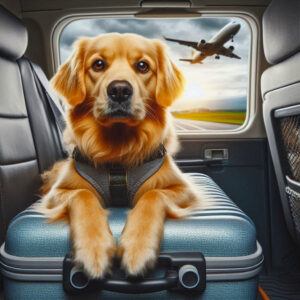Journeying Together:
Essential Tips for Safe & Comfortable Pet Travel
Your first step should be scheduling a vet visit. A quick check-up can ensure your pet is healthy and ready for travel. You can also arrange any necessary vaccinations and health certificates during this visit.
- Packing might seem straightforward, but there’s much to consider. Pack your pet’s regular food, medications, and comfort items, like a favorite blanket or toy. These familiar items can help your pet feel safe and secure during the trip.
- Choosing a suitable carrier or crate is super important. It should be spacious enough for your pet to stand, turn, and lie down comfortably. Make sure to introduce your pet to their travel carrier well in advance so they can get used to it. This can reduce their stress when it’s time to hit the road.
- Leaving the carrier open in your house with some toys or goodies inside is an excellent approach to getting your pet used to it. This produces positive associations. Additionally, think about taking them on quick practice excursions to assist them in becoming used to riding in the carrier.
- In addition to these steps, make sure your pet’s collar has a tag with up-to-date contact information, and consider getting them microchipped if it isn’t already. In a new environment, it’s easy for pets to get disoriented, and proper identification is crucial just in case they wander off.
Selecting Pet-Friendly Destinations
Discovering lodging that allows pets might significantly impact how much you enjoy your trip. Many hotels and vacation rentals now cater to pet guests, offering amenities like dog parks, pet beds, and welcome treats. Always ensure your chosen lodging has a pet policy to avoid unpleasant surprises.
When traveling with pets, it’s essential to learn about the pet policies of the pet carrier, especially airlines. Airlines have different rules for pets traveling in the cabin versus the cargo hold, so ensure you’re aware of size and breed restrictions and any additional fees.
- Exploring pet-friendly activities and attractions in your destination city can significantly enhance your experience. There are many things to do with your pet, including dog-friendly beaches, hiking trails, and even pet-friendly eateries. Look for local parks and outdoor spaces where your pet can romp freely and safely.
- When choosing a destination, your pet’s comfort level and temperament are important factors. Certain pets do better in busy, action-packed settings, while others enjoy the quiet of more sedate, natural settings. When deciding where to go, take your pet’s personality into account.
- Scheduling pet-inclusive activities can give your vacation a special touch. Many destinations offer special excursions designed with pets in mind, such as dog-friendly boat tours, pet spa days, and even pet yoga classes. Including your pet in your activities makes the journey more fun and memorable for both of you.
Safe Travel Practices
Securing your pet in the vehicle is non-negotiable for a safe trip. Use a pet seatbelt, harness, or a well-ventilated crate to keep them from moving around during the drive. Not only does it ensure your safety, but it also minimizes distractions. Some pets can get car sick, just like humans. Managing motion sickness can involve withholding food for a few hours before the trip and keeping your vehicle well-ventilated. If your pet gets nauseous, talk to your vet about possible medications.
Regular breaks are essential to keeping your pet comfortable. Plan rest stops every couple of hours so your pet can stretch, hydrate, and get bathroom relief. This is especially crucial on longer journeys.
On the road, you must pay extra attention to nutrition and hydration. Carry a portable bowl and lots of water with you, and make every effort to feed your pet on their usual schedule. This helps maintain a sense of normalcy for your pet.
Handling Unexpected Situations
- Emergencies or delays in transit are possible. Always have a backup plan. Bring extra food, water, and any prescription drugs your pet may require. Familiarize yourself with nearby pet-friendly hotels and rest areas, just in case.
- Accessing veterinary care while away is crucial. Research and note down the contact details of veterinarians along your route and near your destination. Knowing where to go in an emergency can save precious time and stress.
- Make sure the pet’s identity is current. The tag should have your current phone number, and the microchip information must be appropriately registered. This preparedness makes things easier if you and your pet become separated.
- Keep up-to-date pictures of your pet on your phone to prepare for any pet loss situations. This can be invaluable when creating lost pet flyers or showing people who to look for.
- Pet travel insurance might make all the difference. It provides coverage for unforeseen costs, including emergencies or unexpected events, veterinary consultations, trip delays, and cancellations. Look into policies specific to traveling with pets to find what fits best.
Post Trip Care and Adjustments
Following the journey, your pet may require some time to adjust to the new surroundings. Provide your pet with comforting and familiar objects, such as beloved toys or blankets, and allow them to explore at their own speed. 
- Keep an eye out for any signs of stress or illness. Traveling can be exhausting, and strange behavior might be a sign that your pet needs more attention. See a nearby veterinarian without hesitation if something seems strange.
- Establishing a routine can help your pet settle in more quickly. Please make an effort to follow their normal walking and feeding schedule. A predictable routine brings a sense of normalcy and comfort in a new place.
- Reassurance and comfort are vital for your pet. To help them feel secure, spend quality time playing, cuddling, and engaging in their favorite activities.
- Schedule the return trip well in advance. Ensure that your pet has enough supplies for the trip and that all appointments, including doctor visits and lodging, have been confirmed. This will make heading back home as smooth as possible.
If you have any questions, personal experiences or tips to share, I’d love your feedback. Please make comments below. Thanks for joining me on this journey to stress-free travel with pets!
-Janice-

